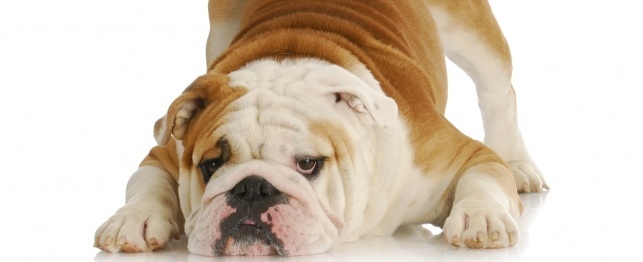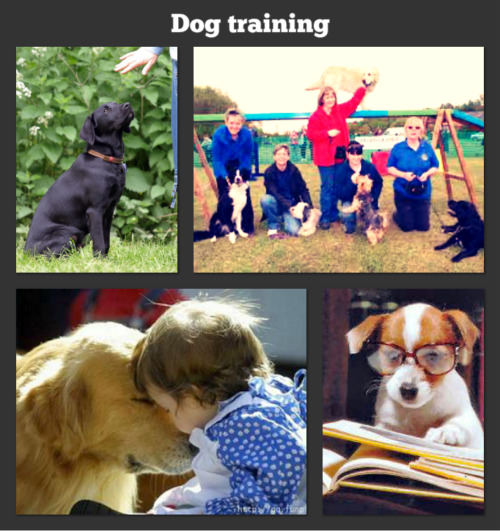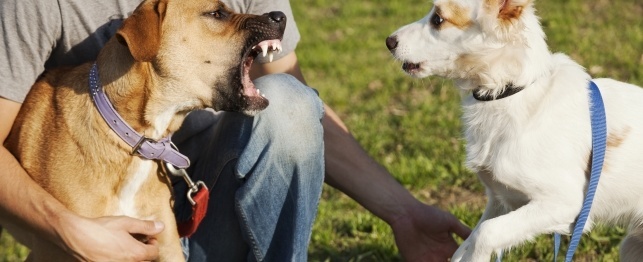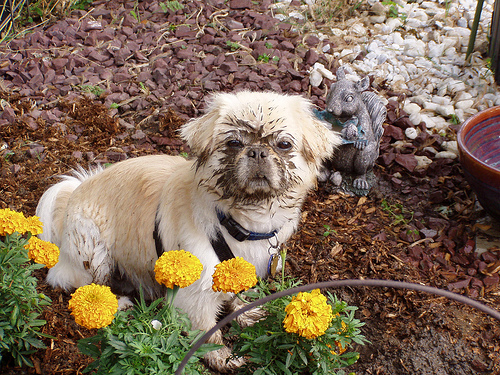More common dog behaviors you should know about; Dog begging may be cute but it's a bad habit. Many owners encourage it, at least at first, only to discover that they can't eat a meal or snack without their dog looking at them with pleading eyes or putting a paw on their knee. Begging is more than aggravating for the owner; it can be bad for your dog.
Many dogs can develop digestive problems or become obese because of the extra weight they gain through begging. Remember that there are better ways to show your dog you love him than giving him extra food. When preparing to eat you should tell your dog to go to his place and stay there, preferably some place where he can't stare at you with sad eyes. You may even need to confine him to another room during meals if you can't resist feeding him at the table. This is for his own benefit. If he behaves well (no crying, howling or scratching at the door), you should give him a special treat after you and your family are finished eating. His reward doesn't have to be food! You can reward your dog with praise, a game, and lots of love.
2. Dogs Chase
Many dogs have a strong urge to chase moving things. This is a holdover predatory instinct from their days as hunters. They are programmed to chase other animals, even people and cars -- it can be anything that moves. Unfortunately, this tendency to want to chase moving objects can lead to disaster. You may not be able to prevent your dog from wanting to chase things, but you can teach him to learn other behaviors.
Keep your dog on a leash when outside. Train your dog to come when called (all dogs should ideally know this) Watch for potential triggers for your dog's chase instinct, such as joggers or cats. Have a dog whistle or noisemaker with you so you can get your dog's attention when necessary
Keep your dog under control when you're out in public and be very careful when opening gates and doors leading to the street. Take care to teach your dog to focus his attention on you and you can prevent him from chasing things. It's all too easy for a dog to start chasing something and to accidentally become lost or to run out into the street.
3. Dogs Jump Up
Jumping up behavior begins with puppies jumping up to reach and greet their mothers. It's a short step for them to jump up to greet people. Dogs can also learn to jump up to try to show dominance. Of course, jumping dogs are not very pleasant to be around. They can be annoying or even dangerous, especially to small children.
There are many ways to teach a dog not to jump up but they may not all work with different dogs. You can lift your knee to meet the dog when he jumps on you, grab his paws, or simply push the dog away. Unfortunately all of these methods succeed in giving the dog what he craves -- attention. The best way to teach a dog not to jump on you may be to ignore the dog. When your dog jumps up on you, turn away from him. Do not look at him, speak to him or touch him. Do not acknowledge him in any way. When your dog relaxes and remains still then you can calmly reward him. Your dog will figure out that this is the desired behavior.
4. Dogs Bite
It is quite normal for dogs to bite. It has nothing to do with being "bad" or aggressive or dangerous. Dogs bite out of instinct. As puppies dogs bite to explore their world. They nip on their littermates or other dogs to find their place in the pack order. They bite as a means of play. What is unusual for them is that they are now part of human packs. As such, it is necessary for humans (dog owners) to teach them that biting and mouthing on people (and chewing on other things) is not an acceptable way of behaving.
Owners have to teach something that is called "bite inhibition." In a puppy's world his mother and littermates begin to teach him this concept but he is removed from them before he is mature. It's up to his owner to continue teaching him that he cannot bite on others. Using a product such as Grannick's Bitter Apple ca be a huge help in teaching your puppy not to bite or mouth.
After puppy hood there are other reasons why dogs bite or snap:
Pain
Fear or Defensiveness
Dominance Assertion
Predatory Instinct
Protection of Property (Jealousy)
Some people urge the idea that some breeds are more dangerous than others. There is no proof of this. Statistics do not show that any particular breed of dog is more dangerous or prone to biting than others. Mixed breeds and the gentle Labrador, the two most populous segments of the dog population, account for more dog bites than any other dogs, proving that if you have more of one kind of dog then you will have more dog bites from that kind of dog. Through the years various breeds have been demonized by the media and the public, including breeds which are beloved now, such as the Collie, which was thought to be quite vicious in the early 1800s before becoming a favorite of Queen Victoria. All dogs need proper training, socialization and good breeding practices.
5. Dogs can be Aggressive
Dog aggression can be shown by growls, snarls, bared teeth, lunges, and biting behavior. It's important to keep in mind that any dog can show aggressive behavior under the right circumstances, no matter their breed or history. Typically, dogs that have been abused or treated with violence or trained to show aggression are more likely to show aggressive behavior toward people or other dogs. The reasons a dog will exhibit aggression are similar to the reasons a dog will bite or snap. However, in general, canine aggression is a more serious problem than a single instance of biting.
If your dog is showing aggressive tendencies or attempting to dominate you, you should consult with your veterinarian. It's possible there could be an underlying health problem involved. If no health problem is found you will need to find an experienced dog trainer. Your dog's aggression will require the help of a professional.

 NILIF Behavioral Shaping For Dogs
Why You Should Consider NILIF
Do you have a stubborn, pushy
NILIF Behavioral Shaping For Dogs
Why You Should Consider NILIF
Do you have a stubborn, pushy
 Dog Games - Try Puppy Push-Ups
Dog Games - Try Puppy Push-Ups
Dog Games - Try Puppy Push-Ups
Dog Games - Try Puppy Push-Ups
 How To Use Vibration Dog Training Collars
All dogs need training at least, no matter how smart the do
How To Use Vibration Dog Training Collars
All dogs need training at least, no matter how smart the do
 Dog Parks and Bites: What You Need to Know
Dog Parks and Bites: What You Need to Know
Dog Parks and Bites: What You Need to Know
Dog Parks and Bites: What You Need to Know
 How To Deal With Dogs That Dig
How To Deal With Dogs That Dig
Digging can be a fr
How To Deal With Dogs That Dig
How To Deal With Dogs That Dig
Digging can be a fr